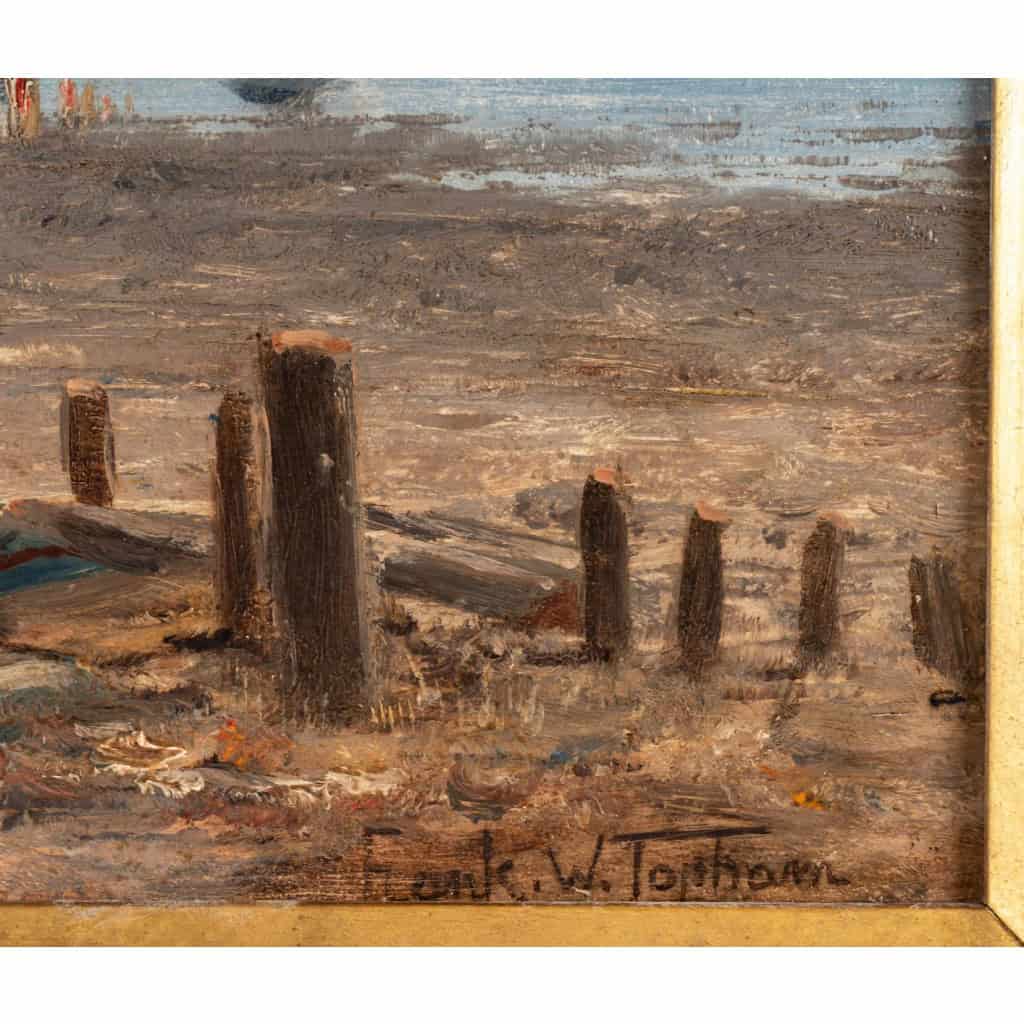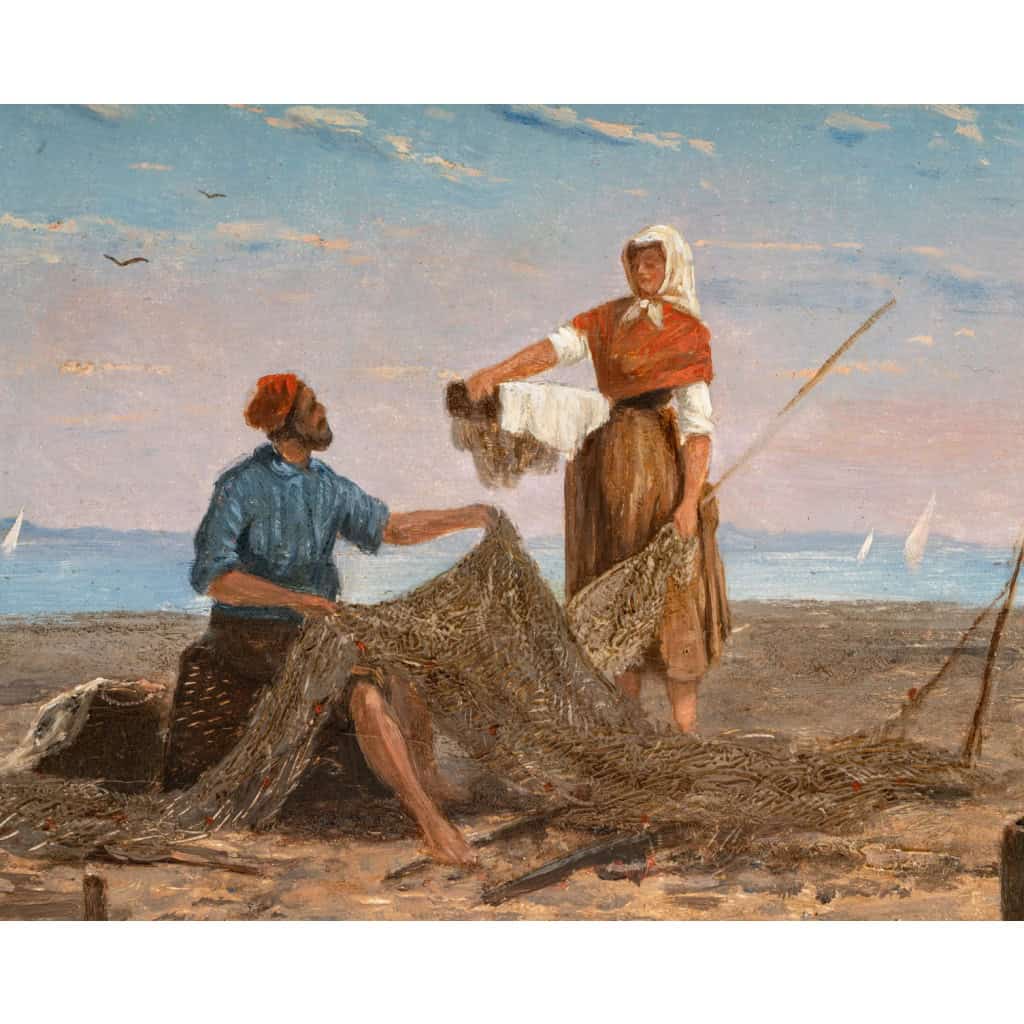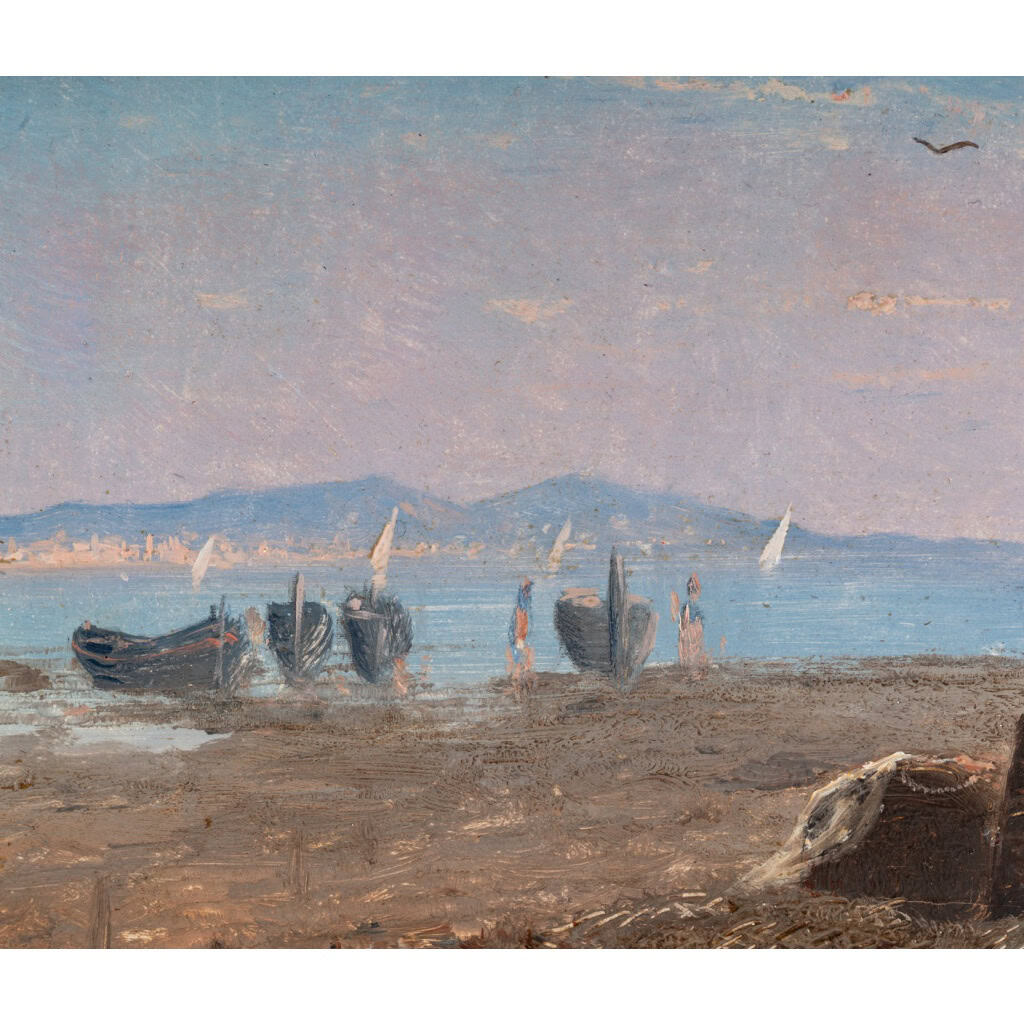Frank William Warwick Topham (1838-1924) Capri La réparation des filets huile sur panneau vers 1863
Un air de fraicheur, une somptueuse lumière pour cette huile sur panneau que nous propose Frank William Warwick Topham, excellent peintre et aquarelliste anglais.
C’est à l’occasion de son séjour avec son père vers 1863 que ce tableau a été imaginé et peint. Une belle composition qui sublime la vie des pêcheurs Italiens dans ce milieu du XIXème siècle et nous donne à rêver à ces paysages baignés de lumière.
Charmant tableau montrant un pêcheur réparant ses filets sur une plage de Capri, signé en bas à gauche par Frank William Warwick Topham vers 1863.
Dimension sans cadre : Hauteur 38 cm – Longueur 46 cm.
Dimensions avec cadre : Hauteur 54 cm – Longueur 75 cm.
En très bon état de conservation, notre tableau est servi par un beau cadre en bois sculpté et patiné. Notre tableau vient d’être nettoyé professionnellement.
Biographie :
Frank William Warwick Topham (1838-1924) est surtout connu comme un peintre de charmantes scènes de genre à l’huile et à l’aquarelle, en particulier celles qui ont pour cadre l’Italie. Il a également réalisé un certain nombre de portraits.
Frank William Warwick Topham est né au 32 Fortress Terrace, Kentish Town, le deuxième des dix enfants du peintre de genre Francis William Topham et de son épouse Mary Anne (née Beckwith).
Il a étudié l’art sous la direction de son père dès son plus jeune âge, avant d’entrer dans les écoles de la Royal Academy. Il poursuit son apprentissage à Paris dans l’atelier du peintre académique Charles Gleyre.
À partir de 1860, Topham exposera largement à Londres et en province, notamment à la Royal Academy of Arts, la British Institution, la Royal Society of British Artists, l’Institute of Painters in Water Colours, la Grosvenor Gallery et la New Gallery.
Topham apprécie la compagnie de son père et entreprend avec lui des voyages de croquis en Irlande en 1860, puis à Rome et à Capri en 1863. Développant un amour particulier pour l’Italie, Il y retourne à plusieurs reprises et fait des habitants de Capri le sujet principal de ses peintures. Un voyage documenté est celui de 1865, lorsqu’il se rendit à Ravenne avec ses collègues peintres, E S Lundgren et Frank Dillon.
En 1870, Topham épouse Helen Lemon, à Horsham, dans le Sussex. Elle était la fille d’un ami de son père, Mark Lemon, le premier rédacteur en chef de Punch. Ils s’installent ensemble au 58 Queen’s Road, St John’s Wood, mais, en 1877, ils déménagent à Ifield, Prince Arthur Road, Hampstead. Ils ont eu cinq filles et trois fils.
En 1879, Topham est élu membre de l’Institute of Painters in Water Colours. (Six ans plus tard, l’institut recevra sa charte royale). Puis, en 1883, il est élu membre de l’Institute of Painters in Oil Colours, deux ans seulement après sa fondation. (L’institut recevra à son tour sa charte royale et deviendra le Royal Institute of Oil Painters en 1909).
Vers 1890, Topham et sa famille déménagent à Coneyhurst, un manoir Tudor dans le village d’Ewhurst, dans le Surrey, qu’il a modernisé et agrandi. Il conserve toutefois un studio à Londres, Garden Chambers, 32 Great Ormond Street, et continue à peindre et à exposer jusque dans les premières années du XXème siècle. Il meurt chez lui le 25 mai 1924, à l’âge de 86 ans.
Lecture complémentaire :
Tom Pocock, Topham and Son. Une famille d’artistes, Londres : Burgh House Museum, 1985.
Frank William Warwick Topham (1838-1924) Capri The Repair of the Nets oil on panel circa 1863
An air of freshness, a sumptuous light for this oil on panel by Frank William Warwick Topham, an excellent English painter, and watercolorist.
It was during his stay with his father around 1863 that this picture was conceived and painted. A beautiful composition that sublimates the life of Italian fishermen in the middle of the 19th century, and makes us dream of these landscapes bathed in light.
Charming painting depicting a fisherman mending his nets on a beach in Capri signed lower left by Frank William Warwick Topham circa 1863.
Sizes unframed: H 14.96 In. – W 18.11 In.
Sizes with frame: H 21.25 In. – W 29.52 In.
In fine condition, our painting is served by a beautiful carved and gilded wooden frame. Our painting has just been professionally cleaned.
Biography:
Frank William Warwick Topham (1838-1924) is best known as a painter of charming genre scenes in oil and watercolor, especially those set in Italy. He also painted a number of portraits.
Frank William Warwick Topham was born at 32 Fortress Terrace, Kentish Town, the second of ten children of genre painter Francis William Topham and his wife Mary Anne (née Beckwith).
He studied art under his father from an early age, before entering the schools of the Royal Academy. He continued his training in Paris in the studio of the academic painter Charles Gleyre.
From 1860 onwards, Topham exhibited widely in London and the provinces, notably at the Royal Academy of Arts, the British Institution, the Royal Society of British Artists, the Institute of Painters in Water Colours, the Grosvenor Gallery, and the New Gallery.
Topham enjoyed his father’s company and went on sketching trips with him to Ireland in 1860 and to Rome and Capri in 1863. Developing a particular love for Italy, he returned there several times and made the people of Capri the main subject of his paintings. A documented trip is that of 1865 when he went to Ravenna with his fellow painters, E S Lundgren and Frank Dillon.
In 1870, Topham married Helen Lemon, in Horsham, Sussex. She was the daughter of her father’s friend Mark Lemon, the first editor of Punch. They settled together at 58 Queen’s Road, St John’s Wood, but in 1877 they moved to Ifield, Prince Arthur Road, Hampstead. They had five daughters and three sons.
In 1879, Topham was elected a member of the Institute of Painters in Water Colours. (Six years later, the Institute received its Royal Charter). Then, in 1883, he was elected a member of the Institute of Painters in Oil Colours, only two years after its founding. (The institute would in turn receive its Royal Charter and become the Royal Institute of Oil Painters in 1909).
Around 1890, Topham and his family moved to Coneyhurst, a Tudor mansion in the village of Ewhurst, Surrey, which he modernized and expanded. However, he retained a studio in London, Garden Chambers, 32 Great Ormond Street, and continued to paint and exhibit well into the early years of the 20th century. He died at his home on May 25, 1924, at the age of 86.
Further reading:
Tom Pocock, Topham, and Son. A Family of Artists, London: Burgh House Museum, 1985.




























